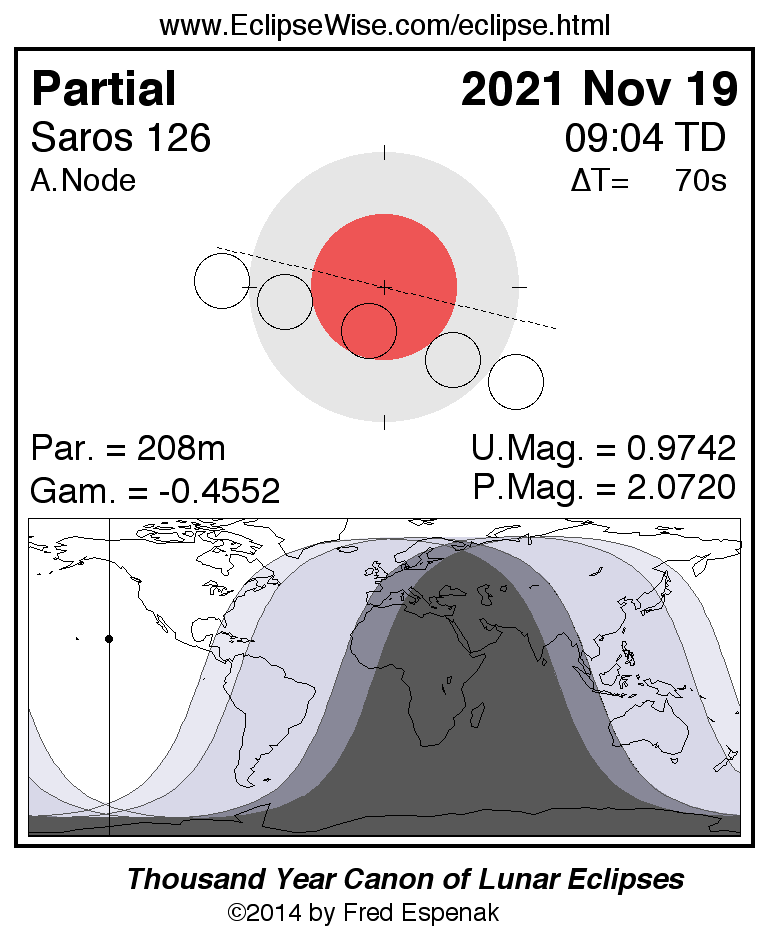THE SOUTHWORTH PLANETARIUM
70 Falmouth Street Portland,Maine 04103
43.6667° N 70.2667° W
Altitude: 10 feet below sea level
Founded January 1970
2021-2022: VIII
"Keeping a steady eye on a complex sky."
THE DAILY ASTRONOMER
Tuesday, September 14, 2021
November's Micromoon Eclipse Part II: The Two Diagrams
We love maps and diagrams with a flaming passion because they are designed to convey an immense amount of information with the fewest number of symbols possible. A well-crafted little sheet can encapsulate pages and pages of information. Today's lunar eclipse article focuses on the diagram below which consists of a diagram and a map or, if you prefer, two diagrams in one.
The two concentric circles in the center show Earth's inner shadow (the umbra) and the outer shadow (the penumbra). The straight line slicing across the circles shows the moon's path from the time just prior to the eclipse to just after.
The smaller circle represents the moon to scale relative to the shadows.
PARTIAL:
We here define four types of lunar eclipse. A total lunar eclipse occurs when the entire moon enters Earth's umbra, or inner shadow. A partial lunar eclipse occurs when only part of the moon passes through the umbra. A penumbral eclipse happens when the moon passes entirely into Earth's penumbra, outer shadow, but does not touch the umbra. Finally, a partial penumbral eclipse occurs when only part of the moon moves into the penumbra. This eclipse is partial because the moon's southern limb will not enter the umbra.
SAROS 126:
Every eclipse is part of a Saros cycle. Each eclipse within a given saros shares the same "geometry" as the other eclipses within that series. (We are going to devote ALL of Wednesday's DA to discussing the Saros cycle in more detail.) Successive eclipses within the same Saros series are separated by 18 years and 11 days. The previous Saros 126 lunar eclipse occurred on November 9, 2003. The next Saros 126 lunar eclipse will occur on (well, can you guess?)*
The first Saros 126 eclipse, a partial penumbral, happened on July 18, 1228 and the last will occur on August 19, 2472.
A NODE:
This stands for "ascending node." Lunar eclipses can only occur when the moon is at opposition (full) around the time it reaches a node, an intersection connecting the lunar orbit and Earth's orbit. Intersecting orbits produce two nodes, one at which the orbiting body passes north of the parent body's orbital plane (the ascending node) and one at which the orbiting body passes south of that plane (the descending node).

As this eclipse series occurs at the ascending node, the path of each eclipse will be slightly lower than the one that preceded it. Conversely, the path of each eclipse within a series occurring at the descending node will be higher than the path of the previous eclipse within that series. We will discuss this matter in greater detail in tomorrow's Saros article.
PAR = 208 mSimply, the duration of the partial umbral eclipse.
GAM = - 0.4552
This gamma term pertains to the distance separating the moon's center and the umbra's center at the moment of maximum eclipse. The unit is Earth's equatorial radii.
9:04 TD
The time of maximum eclipse. The TD refers to terrestrial dynamical time, which is based on atomic time that is unaffected by external factors, such as irregularities in Earth's rotation.
Delta T = 70 s
The time difference between dynamical time and universal time resulting primarily from Earth's rotational irregularities.
U. Mag = 0.9742
Umbral magnitude equals 0.9742. This magnitude measures the percentage of the moon's diameter immersed in the umbra. 97.42%
P. Mag = 2.0720
Penumbral magnitude. The fraction of the moon's diameter immersed in the penumbra. This value is measured from the edge of the penumbra to the point on the moon that is in the deepest part of the shadow.
THE SECOND DIAGRAM:
The second diagram, located at the bottom of the above chart, displays a visibility map: regions where the eclipse is totally visible, partially visible or not visible at all.
The areas steeped in the darkness (most of Africa, the Middle East, Antarctica, regions in Russia and Europe) won't see any of the eclipse because the moon will not be above the horizon at those locations.
Observers within the areas covered in darker grey strip at either side of the dark region will only see the penumbral eclipse, i.e. not much at all. For instance, a moon watcher in extreme western Australia will see the penumbral eclipse ending as the moon rises. Meanwhile an observer in Morocco would see the penumbral eclipse beginning as the moon sets.
Observers within the lighter (and wider) grey areas will see some of the umbral eclipse. Most observers in Australia will see the umbral eclipse in progress as the moon rises. Those Australian sky watchers farther to the east will see more than those in the west. Meanwhile, most South American observers will see only part of the umbral eclipse before the moon sets. Eastern South American sky watchers will see less of it than those farther west.
Observers within the grey stripes next to the white regions will see almost all of the eclipse. Those observers in eastern New Zealand will see the moon rise during the first penumbral phase so they will see the rest of it. Those observers in eastern North America (including here in Portland) will see the moon set during the last penumbral phase. (We won't miss much.)
Finally, observers within the white regions including almost all of North America and northeastern Russia will see all of the eclipse.
All of that information contained within a small rectangle.
Tomorrow, our lunar eclipse week continues with what we hope will be a clear explanation about the Saros cycle.
To subscribe or unsubscribe from the Daily Astronomer:

